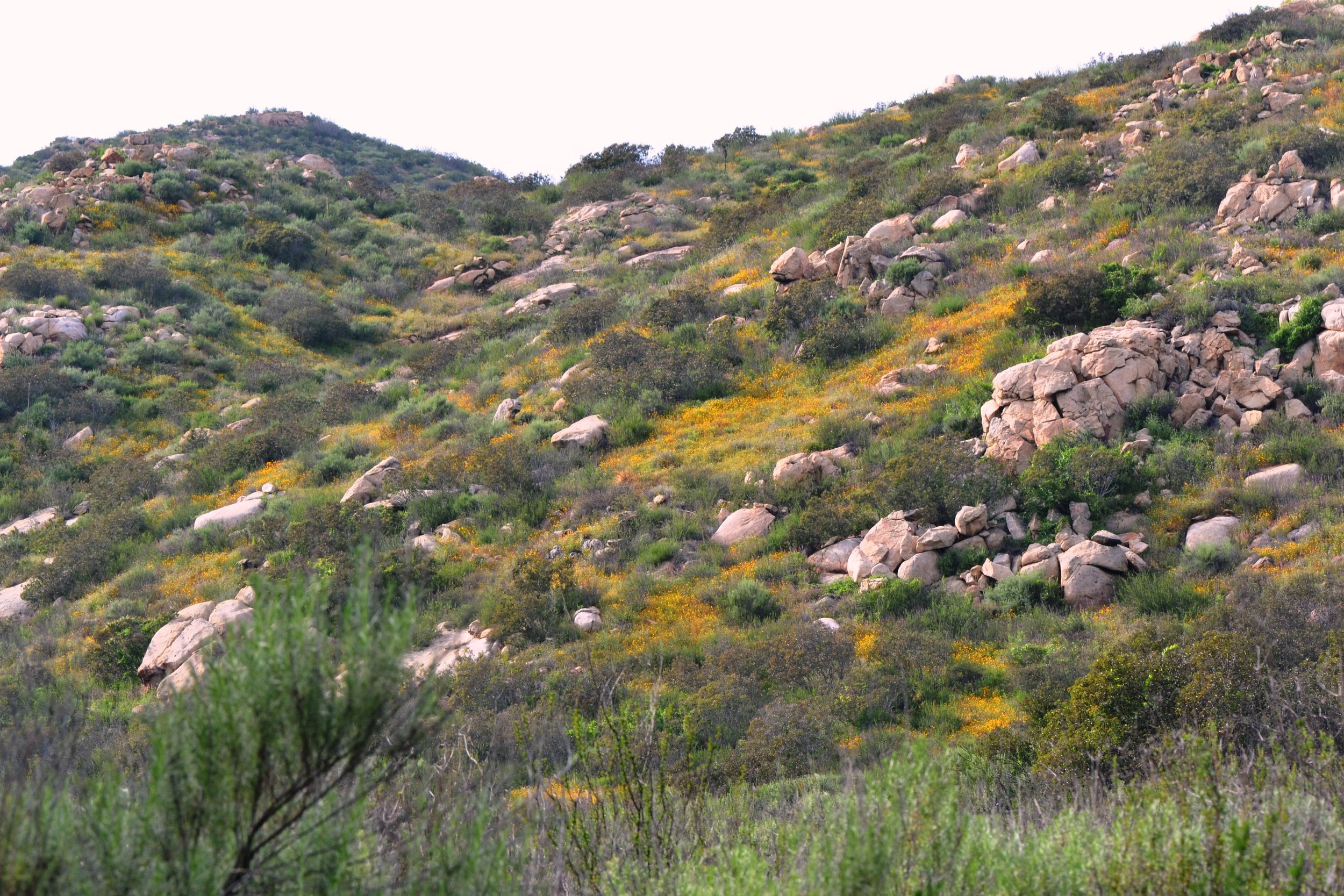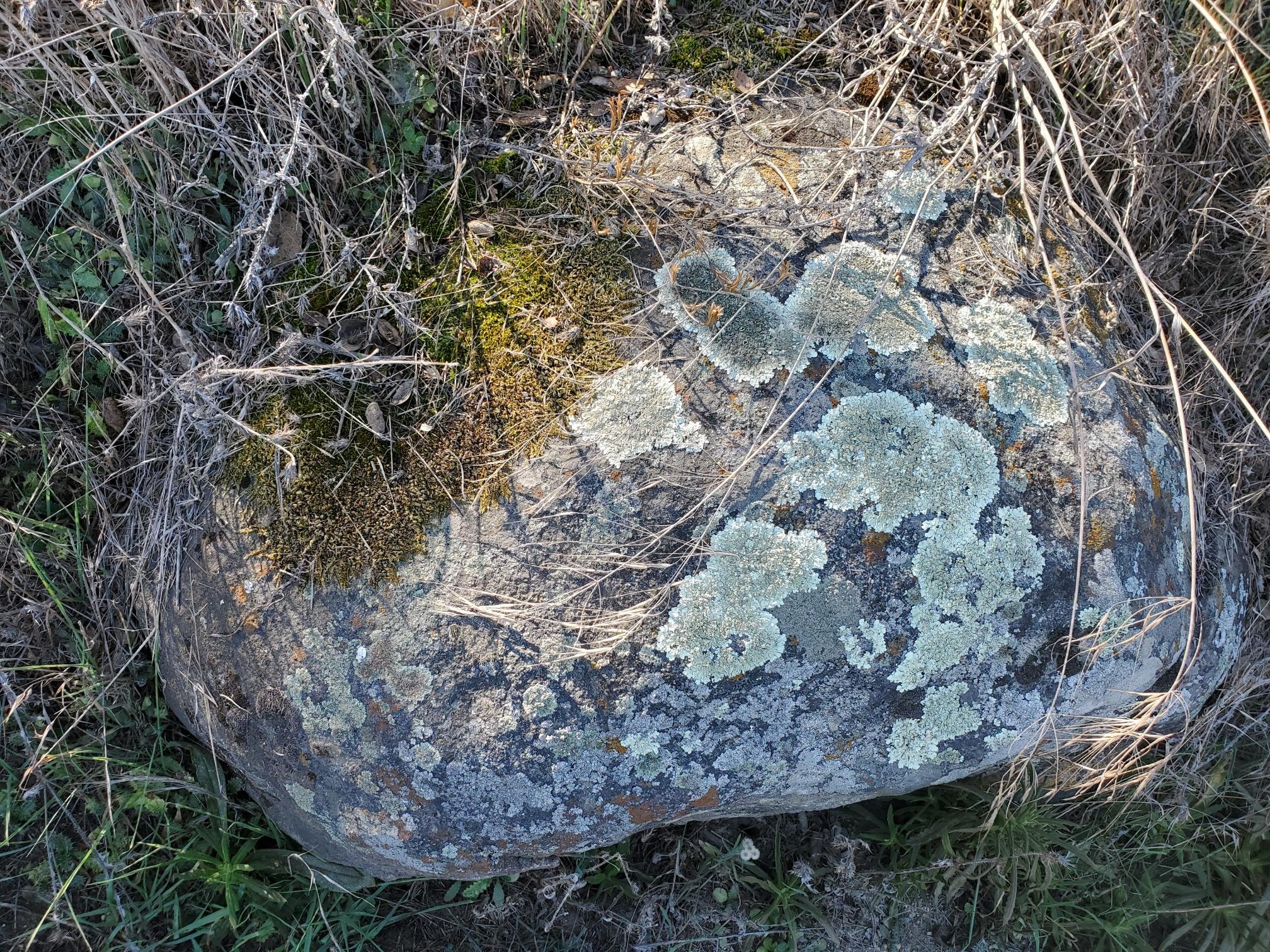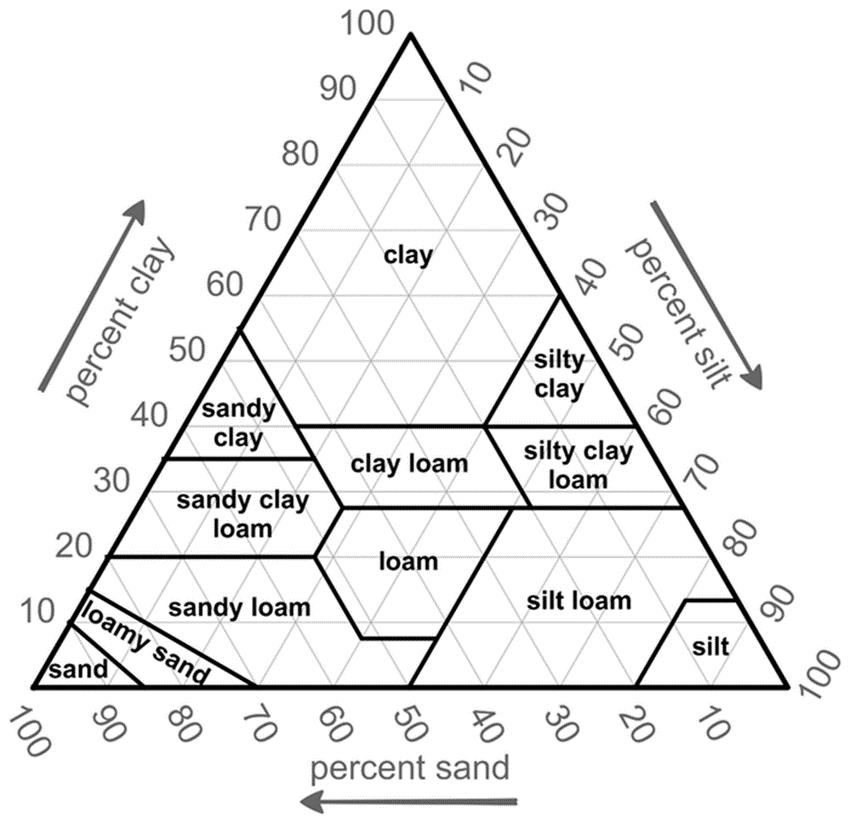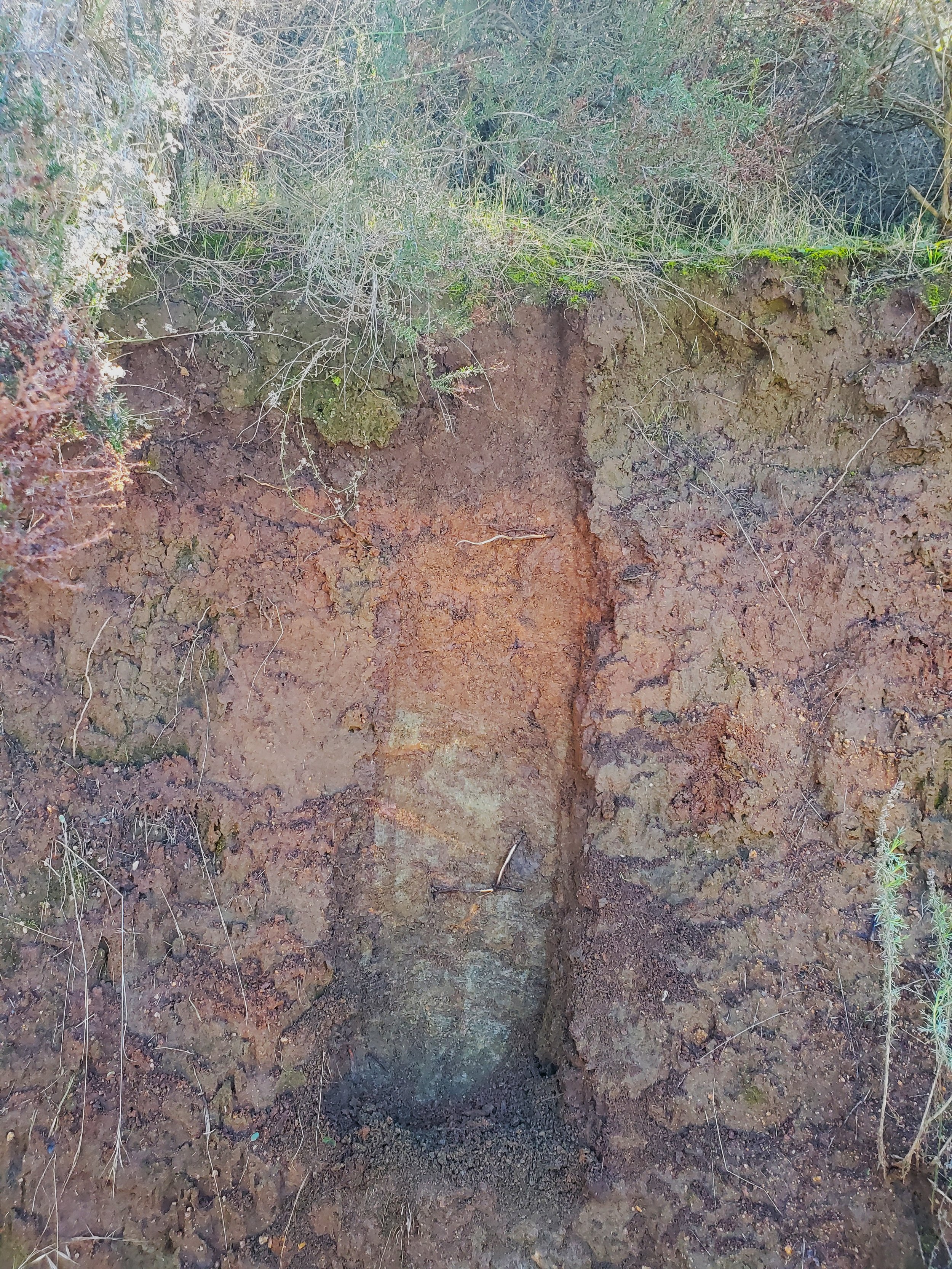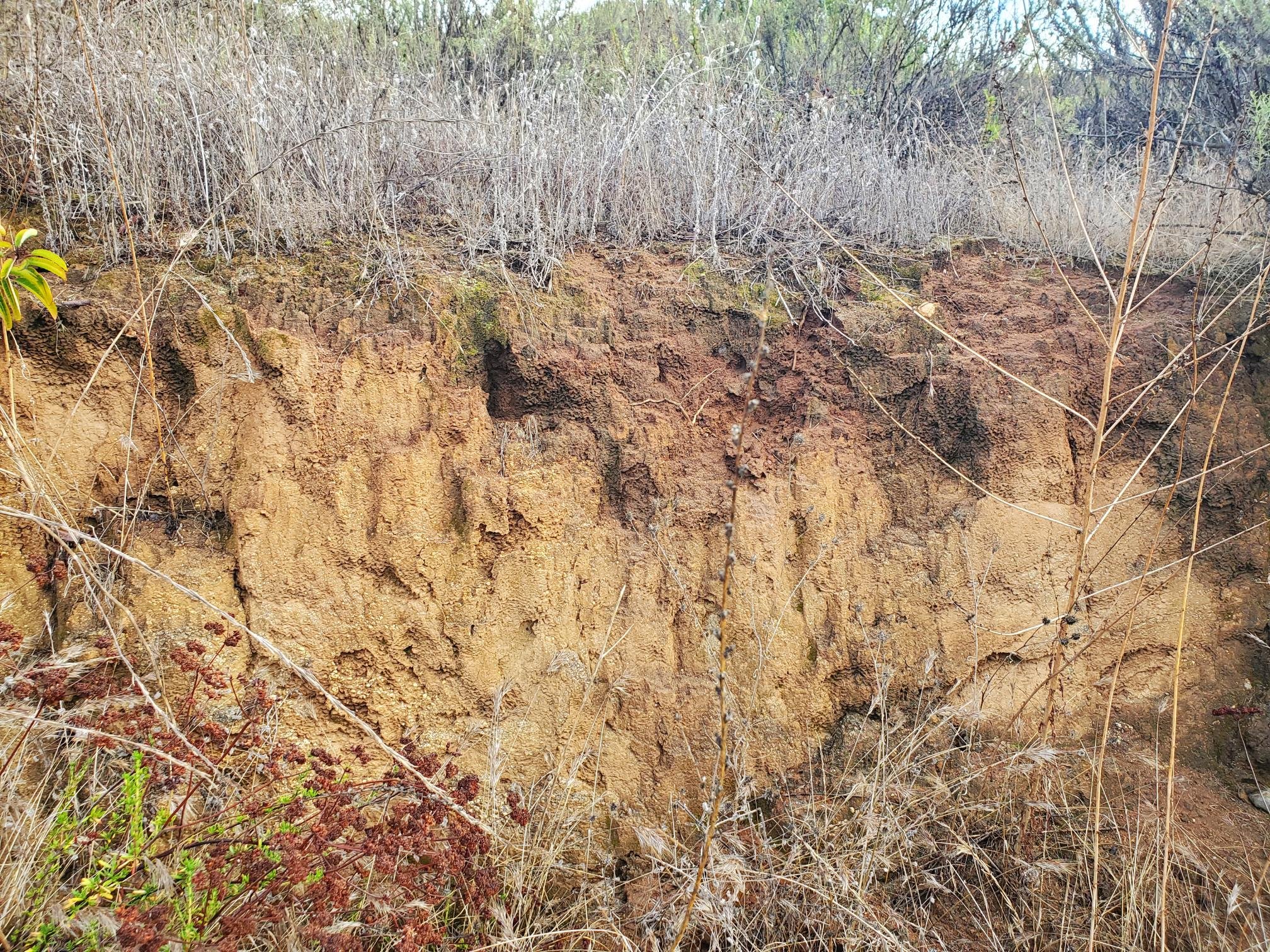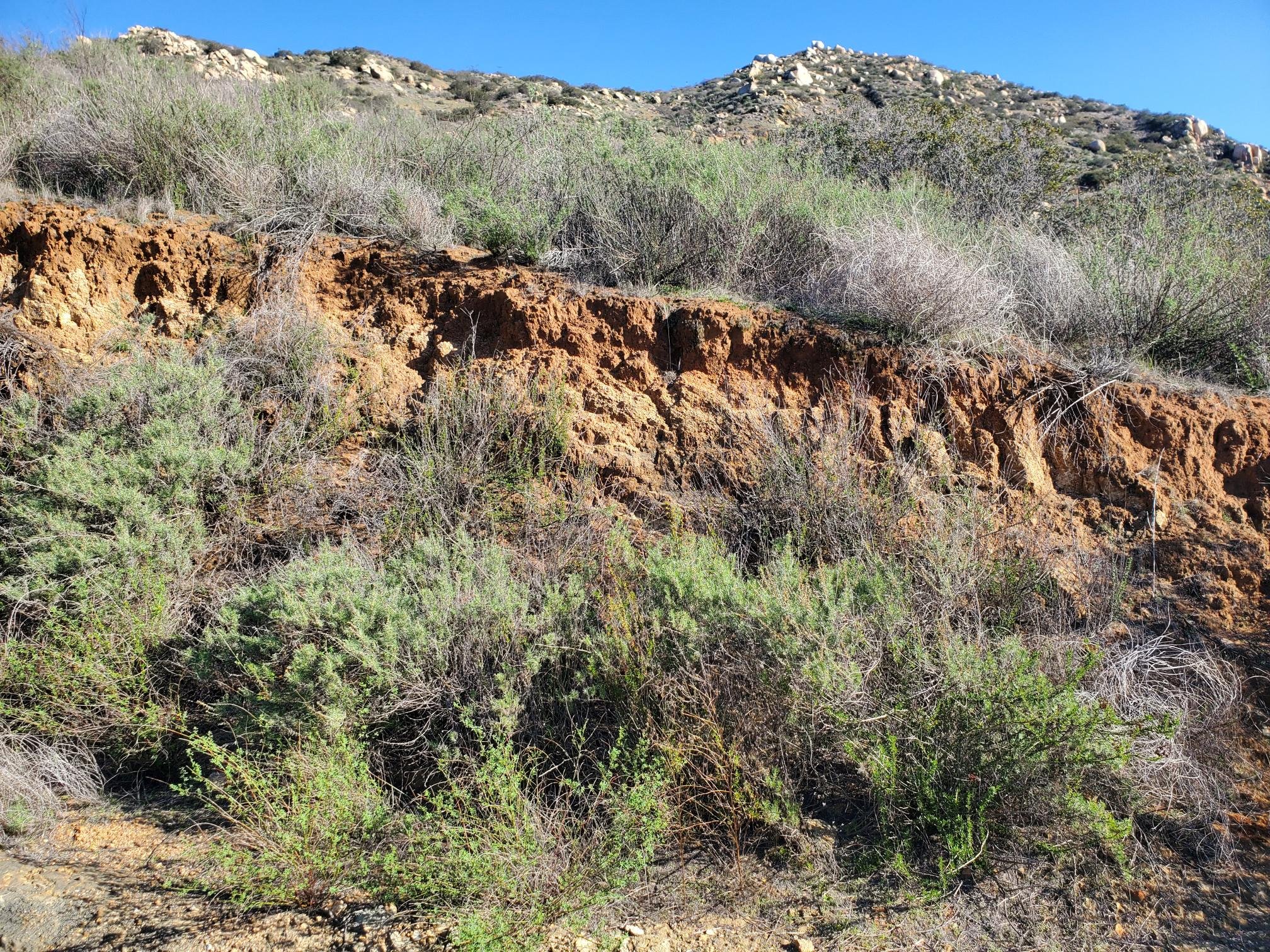Look around the landscape at Blue Sky. In some places you will see rocks and in other places you will see plants. Mosses and lichens can grow (very slowly) on rocks that are in shady spots but larger plants need soil in order to grow, as soil supplies them with both water and nutrients. Without soils, there would be very few trees, shrubs or wildflowers! Plants need nutrients from soil to grow and survive. These nutrients are dissolved in soil water that plants are taking up during the daytime. Plants need water from the soil to control their temperature- without water, plants can overheat and ultimately die.
Granite in Coastal Sage Scrub Habitat Mosses and Lichens
Not all soils are alike
From a plant’s perspective, not all soils are the same, since some soils can supply more water, nutrients and air to plant roots than other soils. Soils are formed from different materials, in different climates, for different amounts of time and in different parts of the landscape. Soils are classified into soil series and mapped so people will know the characteristics of different soils, how to best manage them and how well they will support plants.
At Blue Sky, the material from which all the soils are formed is granite (and other igneous rocks very similar to granite). These rocks and the minerals in them formed deep in the earth at much higher temperatures and pressures than those at the earth’s surface. Now at earth’s the surface, these primary minerals are slowly dissolving and forming new minerals, called clay minerals. This process is called weathering. Depending on their chemical structure, some primary minerals will weather relatively quickly, releasing nutrients in the process, whereas others will take many thousands of years to dissolve. Granite is a rock that can contain as much as 50% of the mineral quartz. Quartz is not only the slowest mineral to dissolve but it doesn’t contain nutrients required by plants. However, granitic rock is composed of other minerals that do contain plant nutrients and, as these minerals weather, plants take up some of the nutrients they contained.
Once plants are established in a landscape, many of the nutrients they have taken up from soil are recycled after their leaves fall or the entire plant dies. Many soil microbial organisms feed on dead plant organic matter and, in the process, release nutrients to the soil environment which are then taken up again by plants. So another way in which soils can differ is in the amount of organic matter they contain.
How to Identify a Sandy Loam or Sandy Clay Loam
Take a small sample of soil, wet and knead it into a small ball, and then squeeze it between your thumb and forefinger to make a ribbon. As you do this, it should feel gritty and should fall apart before it reaches 1 inch in length. If it stays together for more than an inch, then it is a sandy clay loam.
USDA SOIL Texture Triangle
Clay minerals, due to both their very large surface area and to their chemical structure, can retain the nutrients from decomposed plant material and slowly release these nutrients to growing plants. Larger, quartz particles in soil do not do this. Soil particle sizes are clay (smallest), silt and sand (largest). The distribution of particle sizes in soil is called soil texture. A sandy soil consists of mostly sand size particles, whereas a loam will have a mixture of clay, silt and sand size particles. Blue Sky soils have a lot of sand size particles in them because they are derived from granitic rocks, but as they have been weathering for many thousands of years, they have some silt and clay size particles as well. The texture of all Blue Sky soils is sandy loam, which mean they contain some clay and silt size particles, but are predominantly sandy. Sandy loam soils are often favored by gardeners. The high percentage of sand means that the soil will generally have good drainage and good aeration. However, sand size particles don’t retain or supply the nutrients that plants need as well as silt and clay size particles do.
The four soil series at blue sky
The soils in Blue Sky are derived from similar material and have similar texture; the main factor that distinguishes them is their position in the landscape. This will give the soils different characteristics, primarily soil depth and organic matter, that are then used to assign them to different soil series, each with its own name. Soil depth is very important to plants, because it means there is a greater volume of soil for their roots to take up nutrients and water. Landscape position also influences the erosion of soil and the movement of water, which in turn affects the soil, decreasing its depth and organic matter content, and then the vegetation. In consequence, the soil series at Blue Sky are generally associated with one of the 4 habitats.
The Visalia soil is found at the bottom, flat part of the landscape, called the toeslope, near the stream. It is formed from particles that have been carried by water from further upslope and deposited at the bottom of the slope. This material is called alluvium. These soils can be fairly deep (60 inches) and are also in a position where the most water is available in the landscape. This is where the riparian habitat and parts of the oak forest habitat at Blue Sky are found. This biome includes trees such as sycamore and willow, which need water near the surface to survive. Because of the lush vegetation found in this biome, the soil has a lot of organic matter (2.5%) in its surface layer (0-12 inches). This soil is usually dark grayish-brown.
The other 3 soils at Blue Sky are located on the footslopes and backslopes. They differ in depth, with the Cieneba soil being the shallowest soil (4 to 20 inches), followed by the deeper Vista soils (20 – 40 inches) and then the deepest Fallbrook soil (40 - 60 inches) and the degree to which weathering has occurred, with Cieneba being the least weathered and the Fallbrook being the most weathered. Due to landscape position, the Cieneba soil is the most subject to erosion and consequently is younger than the Vista or Fallbrook soil series. You can see Cieneba soils along road cuts as you walk up to the Ramona dam. They are young soils that form on slopes (9-85%) from weathered granite. This soil is primarily associated with the coastal sage scrub habitat within Blue Sky but it is also found on the upper north facing slopes that you can see from the Toretto and Green Valley Truck trails. These soils are often rocky (up to 35% rock fragments). They have a surface layer (A) a bit enriched in organic matter (<1%) on top of weathered granitic material that still has some rock structure (Cr) and may have some cracks in it that roots can grow through.
Fallbrook Series Vista Series Cienaba Series
What are the soils where i live?
There is an easy way to find out! Go to the following site:
https://casoilresource.lawr.ucdavis.edu/gmap/
Click on Menu and choose Zoom to Location. Click on “Automatically display soil data after my location is determined” and then click Use My Current Location. Allow your web browser to determine your current location.
You will see a soils map of your area superimposed on an aerial photograph. (You can choose other images on which to superimpose the soil map by clicking on the layer icon on the right hand side of the screen.) The name of the major soil series associated with the soil map unit you are located in will appear on the left hand side of the screen. The names of other soil series will appear immediately below that because a soil map unit, though primarily one type of soil, will include smaller amounts of other soils. There is information about the primary soil below this and if you click on the highlighted name of your soil, you can get even more information about your soil!
If you want to explore another location, enter location option, such as Blue Sky Ecological Preserve, and then click on go. You will see the soil map for Blue Sky. Just click on one of the map units to learn more about the soils in that map unit.
Contributed by Susan Riha

